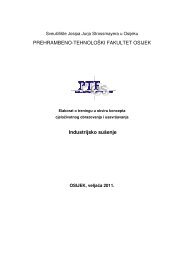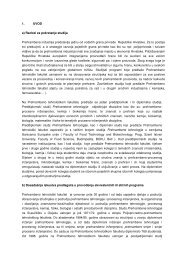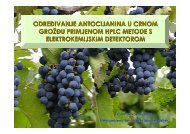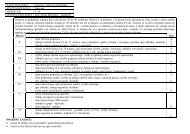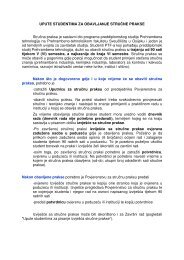ENGLISH IN FOOD TECHNOLOGY I
ENGLISH IN FOOD TECHNOLOGY I
ENGLISH IN FOOD TECHNOLOGY I
You also want an ePaper? Increase the reach of your titles
YUMPU automatically turns print PDFs into web optimized ePapers that Google loves.
UNIT 2<br />
WORSE THAN WE THOUGHT<br />
THE LOWDOWN ON HIGH FRUCTOSE CORN SYRUP AND AGAVE “NECTAR”<br />
By Sally Fallon Morell and Rami Nagel<br />
High fructose corn syrup (HFCS) entered the market place in the early 1970s and within<br />
twenty years, accounted for over half the refined sweeteners used in the U.S. food supply.<br />
Produced mainly by the two food processing giants, Archer Daniels Midland and Cargill, it is<br />
the main sweetener in soft drinks and is increasingly replacing sugar in baked goods, bread,<br />
cereals, canned fruits, jams and jellies, dairy desserts and flavored yoghurts. Sweeter<br />
and less expensive than sugar, HFCS represents the major change in the American diet over<br />
the last forty years. Although the food industry made this change very quietly,<br />
consumers are beginning to ask a lot of loud questions about the new sweetener as research<br />
accumulates to indicate that it is much worse for us than we thought.<br />
Research indicates that free refined fructose interferes with the heart’s use of key minerals,<br />
like magnesium, copper and chromium. In humans, fructose feeding leads to mineral losses,<br />
especially higher fecal excretions of iron and magnesium, than do subjects fed sucrose. Iron,<br />
magnesium, calcium, and zinc balances tended to be more negative during the fructosefeeding<br />
period as compared to balances during the sucrose-feeding period. Because fructose<br />
competes with glucose and galactose for absorption, excess fructose can be carried to the<br />
lower intestine where it provides nutrients for the existing gut flora, which produce gas. It<br />
may also cause water retention in the intestine. These effects may lead to bloating, excessive<br />
flatulence, loose stools, and even diarrhea depending on the amounts eaten and other factors.<br />
All fructose must be metabolized in the liver. The livers of test animals fed large amounts of<br />
fructose develop fatty deposits and cirrhosis, similar to problems that develop in the livers of<br />
alcoholics. Excessive fructose consumption is also believed to contribute to the development<br />
of non-alcoholic fatty liver disease. Fructose is a reducing sugar, as are all monosaccharides.<br />
The spontaneous chemical reaction of simple sugar molecules to proteins, known as<br />
glycation, is thought to be a significant cause of damage in diabetics and an important<br />
contribution to many age-related chronic diseases.<br />
In one study, glycated products were significantly higher in fructose-fed rats compared with<br />
the other sugar-fed and control rats. Although the body does not require insulin to assimilate<br />
fructose, some studies indicate impaired insulin action in the liver and peripheral tissues after<br />
long-term feeding. Fructose reduces the affinity of insulin for its receptor, which is the<br />
hallmark of type-2 diabetes. This is the first step for glucose to enter a cell. As a result, the<br />
body needs to pump out more insulin to handle the same amount of glucose.<br />
Fructose ingestion acutely elevates blood pressure in healthy young humans. Fructose<br />
consumption leads to more lactic acid formation compared to glucose. Extreme elevations<br />
cause metabolic acidosis, even leading to death. A number of studies report elevations in<br />
plasma uric acid after dietary consumption of fructose, especially in patients with high blood<br />
pressure. Elevated uric acid may be a risk factor in coronary disease. This may explain the<br />
findings of a recent study published in British Medical Journal linking fructose to gout. Cases<br />
of gout have risen in recent years, despite the fact that gout is commonly considered a<br />
Victorian disease. The suspect is fructose found in soft drinks and other sweetened drinks.<br />
50







